Scheelite – Mineral Properties, Photos and Occurrence
Scheelite is an important ore of tungsten and exotic faceting material. Great scheelite specimens are also highly appreciated among mineral collectors.
Crystal Structure
Scheelite is a calcium tungstate mineral that is the dominant member of a solid solution series between tungsten-rich scheelite (CaWO4) and rare molybdenum-rich powellite (CaMoO4), a much less common variant. This solid solution explains why most scheelites contain certain amount of molybdenum in their structure.
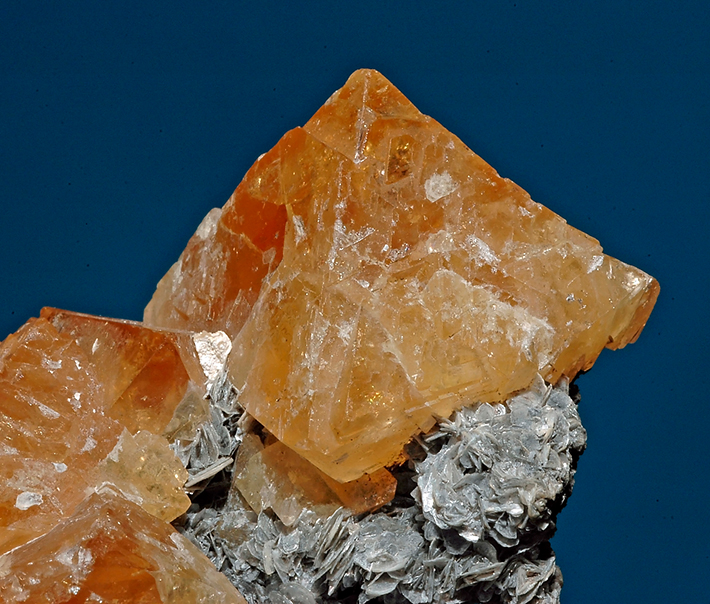
Typical tetragonal dipyramide (looking like octahedron) of orange scheelite on muscovite mica from Yaogangxian Mine, Hunan Province, China. Photo: Parent Géry
Scheelite crystallizes in the tetragonal system, often forming as tetragonal dipyramids which look like octahedrons. Additionally, it may be tabular, massive, granular or columnar, sometimes as grainy aggregates. (A druzy variety is only known from one locality at Cinovec/Zinnwald, in the Czech Republic). Commonly, crystals will exhibit triangular growth layers and twinning, and crystal faces may be striated.
Crystal structure of scheelite is quite different from monoclinic structure of wolframite (ferberite-hübnerite). This explains why Fe and Mn rarely enter the scheelite structure, despite the common association of scheelite and wolframite. However, scheelite can replace wolframite and, because of different structure and density, the mineral volume changes by about 15%.
Physical Properties
Scheelite encompasses a broad range of colors, from bright orange, golden yellow, yellow-brown, brownish green to dark brown, pinkish to reddish gray, orange, pale gray, white and colorless. Transparent varieties are notoriously difficult to prepare as gemstones because of their fragility. Scheelite fluoresces sky-blue to bluish white under short-wave UV light. Any trace content of molybdenum is likely to shift the fluorescence into the green.
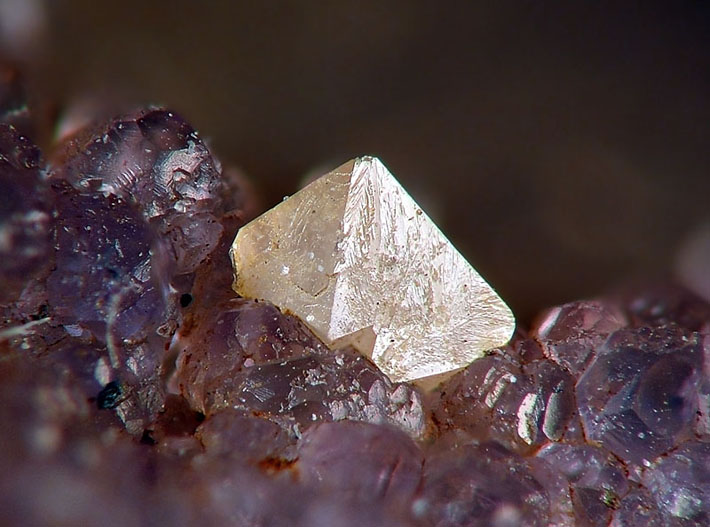
Pale scheelite crystal sitting on purple fluorite from Krupka, Czech Republic. Size: 4 x 3 mm. Photo: Roman Gramblicka
The luster on crystal faces is decidedly lustrous, but degrades to adamantine or greasy on other surfaces. Cleavage is distinct on {101}, interrupted on {112}, and indistinct on {001}. Fracture is subconchoidal to uneven. Its hardness is 4.5-5.0, with a white to yellow streak and an elevated density of 5.9-6.1, owing to the tungsten content.
Similar Minerals
Unfortunately, scheelite in grains or masses is usually white, grayish or colorless and lacks cleavage. It is almost impossible to distinguish it from quartz. Even worse, scheelite is often intergrown with quartz. The only way to detect scheelite is to use the short-wave UV light, as the typical fluorescence immediately reveals the presence of scheelite.
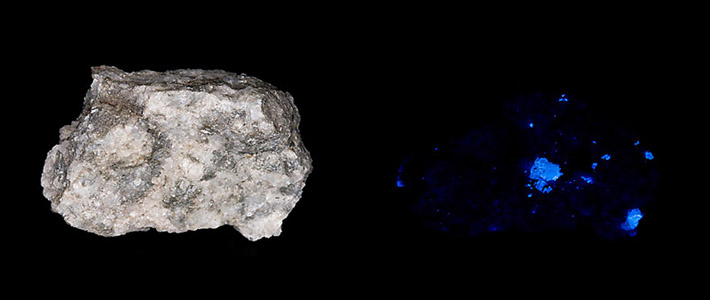
Sample of massive quartz with grains of scheelite from Obri dul, Czech Republic. Left in daylight, right in shortvawe UV light. Size: 6 x 4 cm. Photo: Zbynek Burival
Powellite produces a solid solution with scheelite and can be quite similar-looking. Unlike scheelite, it usually fluoresces yellow and not white/blue. It might be quite difficult to distinguish these two without analyses, but powellite is extremely rare compared to scheelite.
Synthetics
No discussion of scheelite would be complete without addressing the issue of synthetics.
It has been theoretically possible to create synthetic metal crystals since 1916, when a Polish scientist, Jan Czochralski, discovered that he could nucleate a single crystal of tin from a seed dipped in a molten solution of the metal. The Czochralski process has been definitively used to create scheelite substitutes in several fields, some related to technology (discussed in Applications), and some related to gemology.
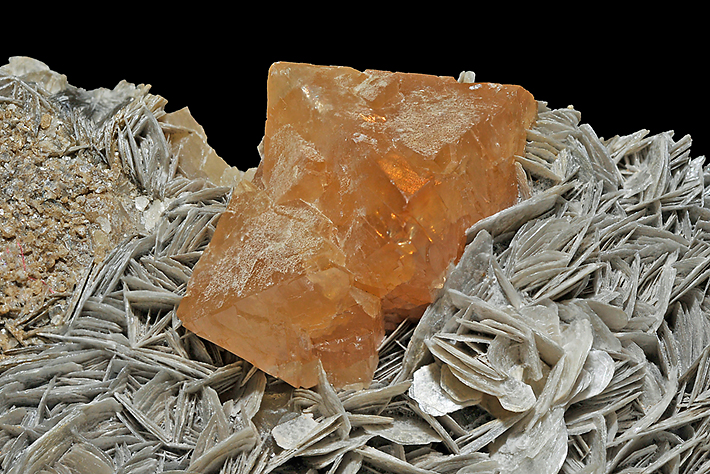
Orange crystals of scheelite on muscovite flakes from Yaogangxian Mine, Hunan Province, China. Photo: Parent Géry
In gemology, there are two areas of concern: the use of synthetic scheelite as substitutes for diamond, and the production of synthetic scheelite for fraudulent replacement of natural scheelite. Cubic zirconia (cubic zirconium dioxide, or ZrO2) and moissanite (silicon carbide, or SiC) have largely replaced synthetic scheelite as a stand-in for imitation diamond, but mineral collectors seeking prized natural scheelite may be fooled into paying high prices for synthetic substitutions.
Fortunately, gemologists have two tools at their disposal to distinguish between the natural and synthetic scheelite.
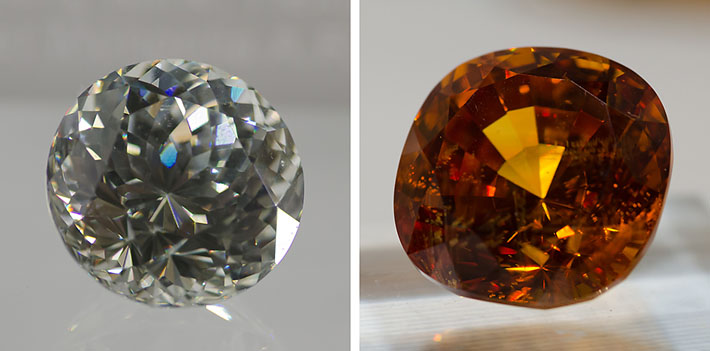
Two big faceted scheelites from China displayed at Munich show 2017. Photo: Zbynek Burival
Under the microscope, natural scheelite will display internal growth structures and inclusion imperfections; synthetics will look clean. Synthetics can also display artificially curved striae and clouds of minute bubbles.
Under the spectroscope, the absorption spectra will be different. Natural scheelite, containing trace amounts of praseodymium and neodymium, will contain faint absorption lines in the yellow (585 nm) portion of the spectrum; synthetic scheelite will not. Attempts to doctor synthetics by doping the crystal with praseodymium and neodymium will fail, because the absorption lines of a doped sample bear no resemblance to the natural spectrum display.
Nomenclature
Scheelite was first recognized in 1781 at the Mount Bispbergs site in Dalarna, Sweden. The heavy weight of the ore sample originally led Swedes to name it tungsten, meaning heavy stone. Later, Carl Wilhelm Scheele (1742-1786), a pharmaceutical chemist, was credited with discovering the tungsten metal within the mineral sample, and the metal element itself was renamed tungsten, and mineral sample name was changed to scheelite in his honor.
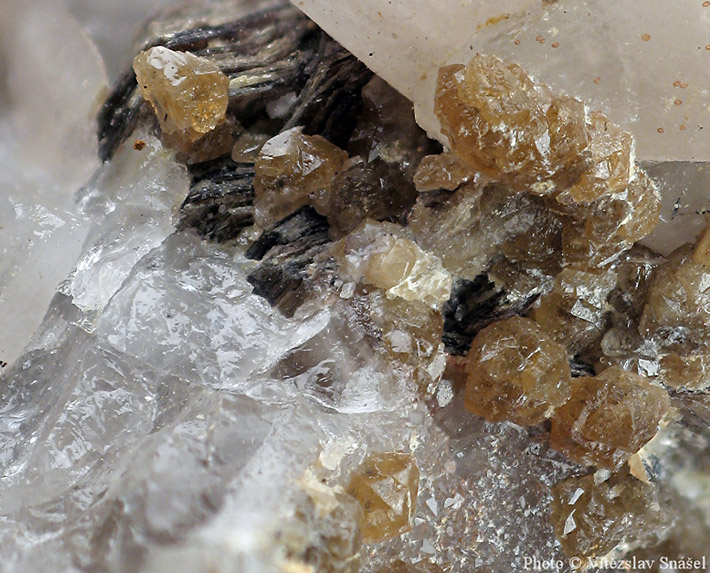
Irregular scheelite crystals on quartz from Cinovec, Czech Republic. Size: 12 x 10 mm. Photo: Vitezslav Snasel
Origin
Scheelite is a mineral most closely associated with high-temperature veins, greisens, granites and various types of skarns. High-temperature veins and greisens are often closely associated with tungsten-bearing granites, where they form in the uppermost part of the granite or spread from it into host rock. These deposits typically contain wolframite, cassiterite, scheelite, molybdenite, fluorite, and zinnwaldite. Common associated gangue minerals are quartz, topaz and feldspars. Many other minerals can be present, including beryl, fluorapatite, arsenopyrite, chalcopyrite, various micas and wide range of secondary minerals. Scheelite can be both primary mineral, formed by magmatic processes, and secondary mineral, which forms by metasomatic processes and replaces wolframite. Also pseudomorphs of wolframite after scheelite are known, they are sometimes labelled as reinite.
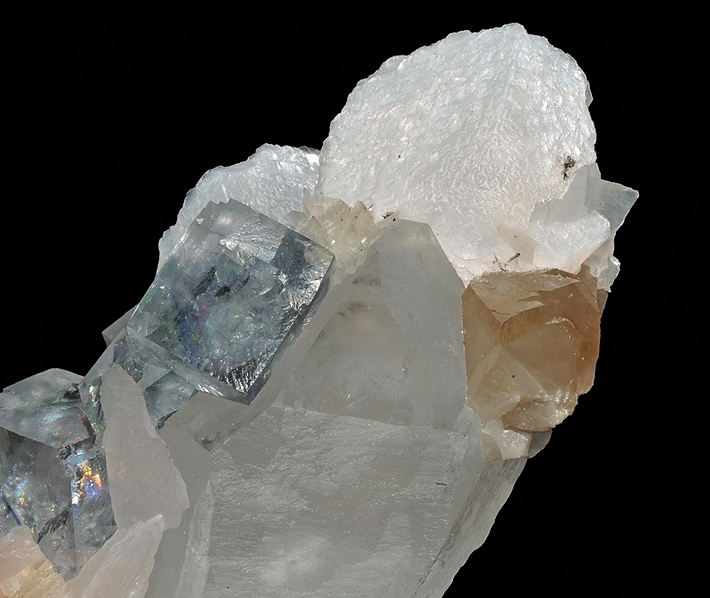
Scheelite and blue fluorite on quartz from Pingwu Beryl Mine, Sichuan Province, China. Photo: Parent Géry
Scheelite is also present in many types of skarns. Some of these are formed by metasomatic processes in the environment rich in calcium and tungsten. Some are formed by regional metamorphosis from volcano-sedimentary sea bed material or by contact metamorphosis when hot granite magma (rich in tungsten) is injected in calcium rich rocks, typically limestones or marbles.
Rare and very pure scheelite crystals are known from alpine clefts.
Applications
Scheelite has been a principal source of tungsten, a dense metal, for many decades. Scheelite, is an important ore of tungsten, but not on a worldwide basis. Most non-US ore is derived from wolframite (Fe,Mn)WO4, whereas scheelite is the dominant source of tungsten ore in the US.

Aggregates of scheelite showing bright fluorescence in shortvawe UV light. In-situ photo in Kristina adit, Kasperske Hory, Czech Republic. Aprox. size of scheelite: 20 cm. Photo: Zbynek Burival
Chronologically, its development as a sole element (used by itself) followed two principal trajectories, one dedicated to use as a filament in electrical lighting (1904), and one dedicated to widespread uses for a malleable hardened metal (1920s). An industrial breakthrough - combining and compressing tungsten and carbon into a super hard tungsten carbide powder - forever increased the usefulness of tungsten.
Lighting
From about 1860 to 1904, experimentation in electric lighting depended on passing a current through a carbon filament to generate incandescent light (and byproduct heat). Carbon filaments were typically mounted in vacuum-based glass bulbs, or in bulbs filled with an inert gas. All such attempts created products with inherent limitations, including bulb blackening, weak illumination, gradual deterioration of the filament and limited life.
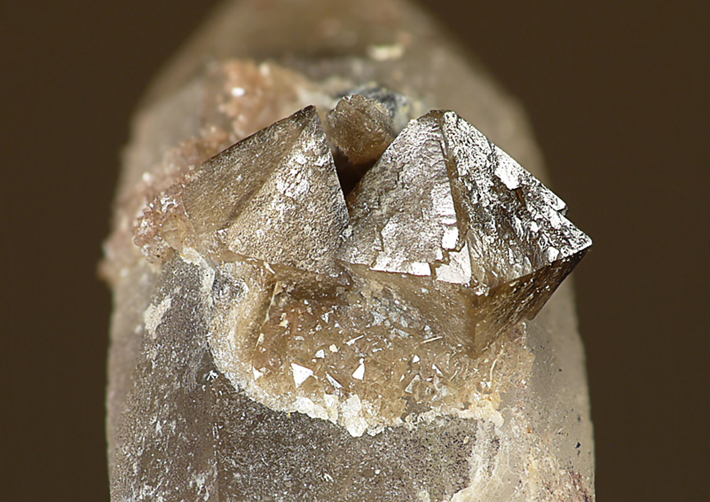
Pale scheelite crystals on quartz from Cinovec, Czech Republic. Size: 6 x 4 mm. Photo: Petr Fuchs
A Hungarian patent for a tungsten filament issued in December, 1904 marked the beginning of a revolution in lighting design. In 1913, vacuum-bulb construction was fully replaced by contained inert gases, dramatically reducing bulb blackening, and increasing temperatures, illumination, and bulb life.
Although incandescent bulbs are cheap to manufacture and purchase, their underlying shortcoming is their thermal inefficiency and long-term energy cost: more than 95% of the energy consumed is generated as heat rather than light. Great inefficiency and environmental regulations in many countries worldwide led to a dramatic decrease in the use of incandescent bulbs.
Tungsten carbide
Tungsten carbide (WC) is a high-value industrial product owing to its resistance to scratches, rust and pitting; it is impervious to attack by nitric, hydrofluoric and sulfuric acid. It is the hardest alloy, with the highest tensile strength at high temperature, a low coefficient of thermal expansion, a high melting point (3410 oC), a high boiling point (5,700 oC) and a Mohs hardness of 9.
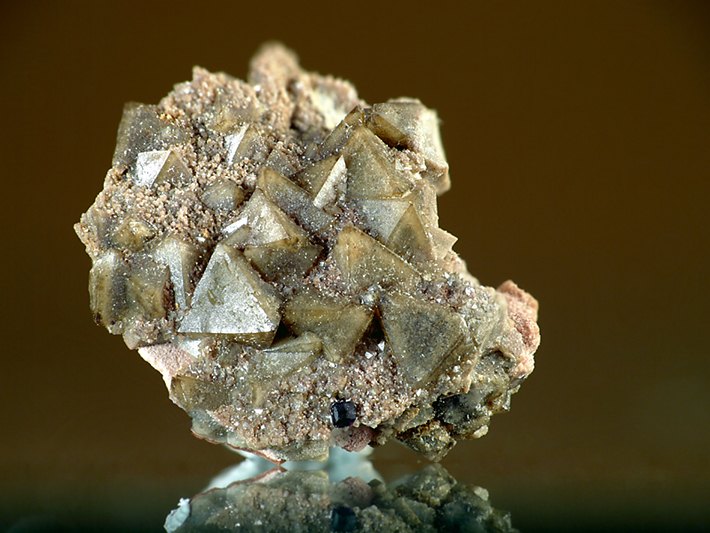
Cluster of scheelite crystals from Krupka, Czech Republic. Size: 2 x 2 cm. Photo: Petr Fuchs
About 90% of the production of tungsten carbide is devoted to an enormous variety of industrial uses. Among them:
Machine tools made of tungsten carbide are superior, especially when mounted as a particle aggregate in a matrix of cobalt. They are more durable, maintain a better cutting edge, produce a better finish on parts and operate faster because of their temperature resistance. It is a common component of high-speed drill bits.
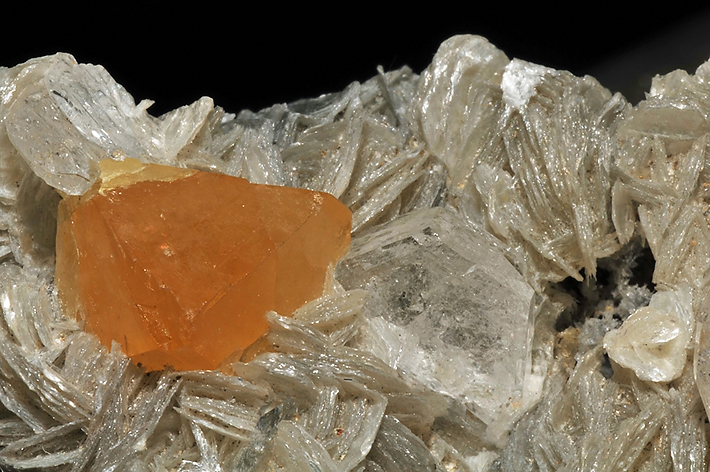
Orange scheelite with quite pale morganite on mica from Pingwu Beryl Mine, Sichuan Province, China. Photo: Parent Géry
Mining is a natural home for carbide applications, where durability and resistance to abrasion are necessary. Principal tools are down-hole pneumatic hammers, button bits (carbide buttons in a softer steel matrix), tunnel-boring machines, and any other application requiring the ability to cut rock quickly.
Industrial alloys are used in combination with other metals (nickel, iron, silver and copper) to fabricate materials for the construction, electronics and aeronautical industries. Some of these applications are as inert-gas welding rods, windings and heating elements for electric furnaces, magnets, electroplating, high-temperature coatings, and rocket nozzles.
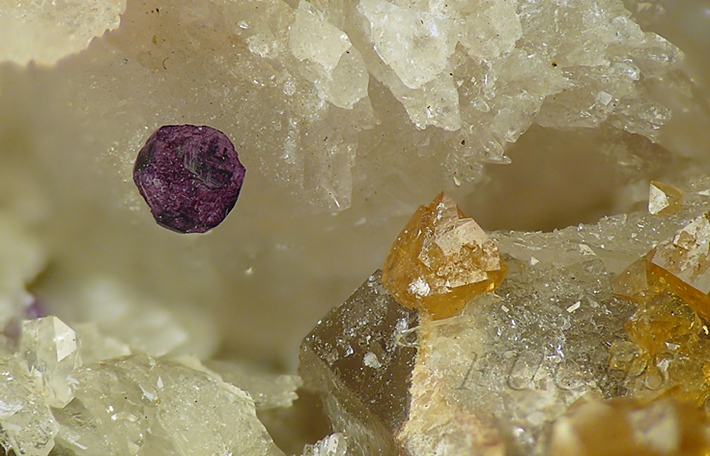
Yellow scheelite and purple fluorite on quartz from Cinovec, Czech Republic. Size: 8 x 5 mm. Photo: Petr Fuchs
Mill products are metallic pieces used as wheels, rods and impact materials suitable for reducing the size of a starting material to any size desired, from coarse fragments to a fine powder.
Jewelry applications account for a tiny fraction of total production, and are concentrated in the wedding industry. The advantages of tungsten in engagement rings and wedding bands are obvious: tungsten rings are scratch-resistant and hypoallergenic, but there are two obvious downsides: tungsten rings cannot be resized, and extreme hardness can also make the ring prone to shattering, and difficult to remove in a medical emergency (where a hand injury creates finger swelling).
Surgical instruments made of tungsten carbide are reported to provide better performance than far less costly stainless steel implements, especially because blades will take a finer edge.
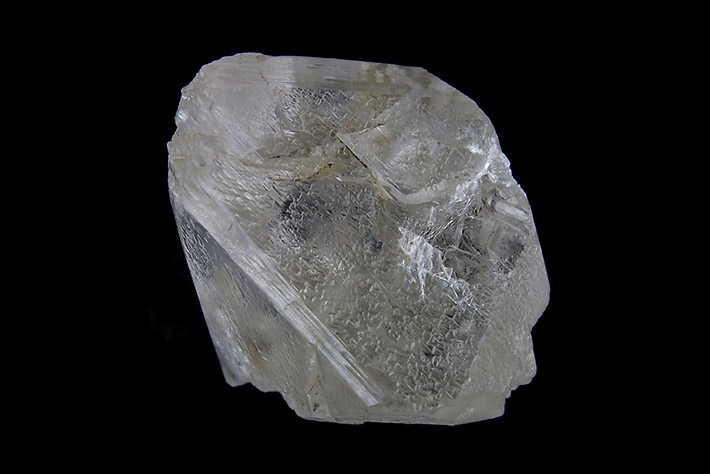
Well developed and rare crystal of scheelite from Alpine clefts in Grimsel area, Switzerland. Size: 2 x 2 cm. Photo: Frantisek Novotny
Ammunition for small-bore applications is another favored use. In land warfare, the carbide is deployed as an anti-tank or anti-armored personnel carrier projectile owing to its hardness and high density.
Sports applications are limited to situations where a sports implement will repeatedly strike a hard surface, such as a trekking pole (on hard rock), dart tips and golf-club heads.
Automotive applications are primarily limited to studs inserted in passenger car tire treads for better traction on snow and ice. Although legal in many countries, most US jurisdictions limit their use to winter driving only. As a result, few areas of the US still use them in any quantity, since tire manufacturers have designed aggressive winter tread patterns as successful replacements.

Tiny scheelite crystals on quartz covered by gray manganite from Cinovec, Czech Republic. Size: 3 x 2 mm. Photo: Petr Fuchs
Nuclear applications are centered on the ability of tungsten carbide to reflect neutrons in atomic research. Famously, two gruesome accidents occurred during nuclear bomb development in WWII Los Alamos/Manhattan Project experiments when neutrons emitted by plutonium were accidentally reflected uncontrollably, and caused the handlers to be fatally irradiated.
Office Supplies: The roller-ball tip in your ball-point pen is likely to be a tungsten carbide product.
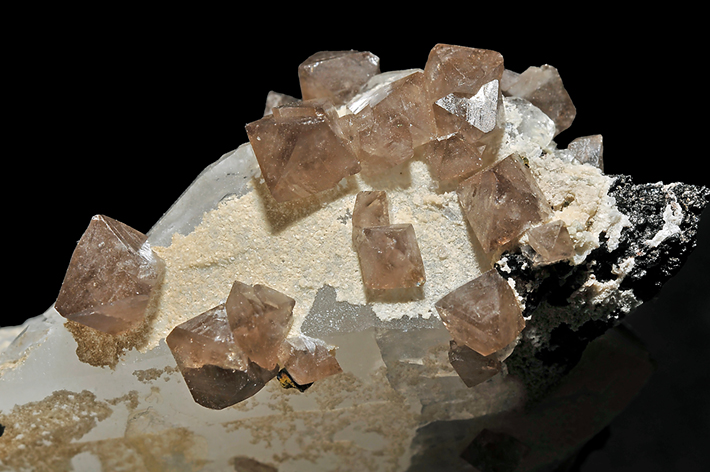
Scheelite crystals on quartz from Pingwu Beryl Mine, Sichuan Province, China. Photo: Parent Géry
Electronics applications is an area where synthetics are widely used. They include items like fine-wire filaments, electrical contact points and switches, heat sinks, electrochemical coatings, X-ray targets, reinforcing substrates for composites made of metal, ceramics and plastic, scintillators which exploit the property of luminescence (reflecting the energy of incoming ionizing radiation), and solid-state lasers.
Occurrence
By far, the most prized specimens are attributed to two mines in China and an old property in the US state of Connecticut.
The finest scheelite crystals, often as bright orange pseudo-octahedrons sitting on nice muscovite matrix come from Mt. Xuebaoding, in Pingwu, Sichuan Province. Smoky crystals come from the Yaogangxian Mine, Chenzhou, Hunan Province.
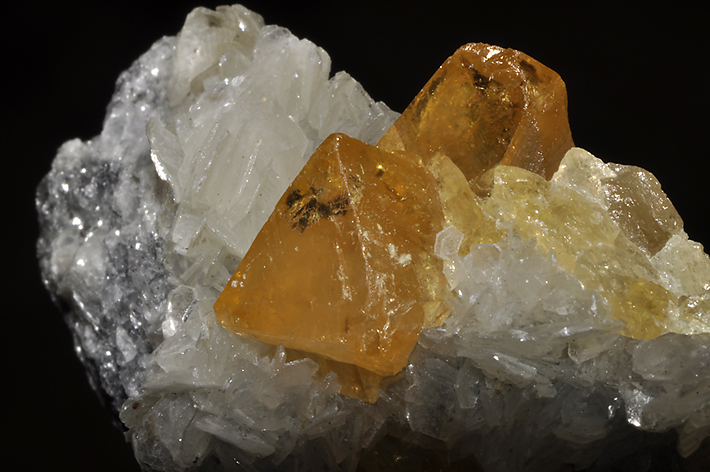
Typical orange crystals of scheelite on quartz from Yaogangxian Mine, Hunan Province, China. Photo: Parent Géry
Large crystals of scheelite completely altered to wolframite have been found at Mounts Kinpu and Kinpo on the boundary between, Nagano and Yamanashi Prefectures, Japan.
Outstanding, sharply crystallized scheelite crystals came from the Tae Hwa Mine, Neungam-ri Province, South Korea.
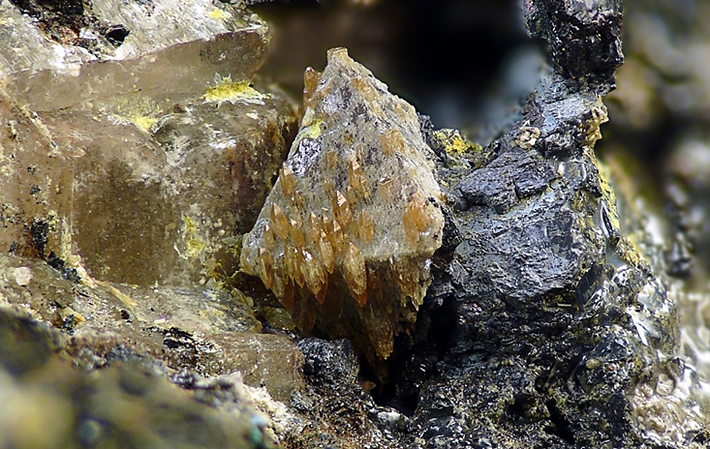
Oriented growths of stolzite on scheelite crystal from Cinovec, Czech Republic. Size: 5 x 4 mm. Photo: Petr Fuchs
Scheelite was mined until 1990 at King Island, Tasmania. Samples were documented at Glenorchy, Central Otago; at Macraes Flat, North Otago; and at Golden Bar Mine, Dead Horse Creek, Nelson in New Zealand.
Abundant scheelite is known from the Zinnwald/Cinovec deposit in Germany and Czech Republic. The German part called Altenberg continues across the border to Cinovec in the Czech Republic. These two sites are often confused, as the old German name of Cinovec is Zinnwald. Nice and large scheelite crystals on clear quartz are known from Obri Dul in the Czech Republic.
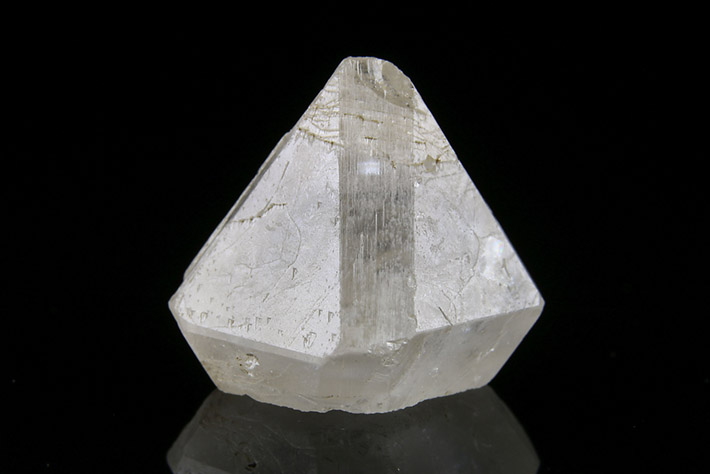
Very rare Alpine scheelite crystal from Grimsel area, Switzerland. Size: 2 x 2 cm. Photo: Frantisek Novotny
Scheelite is mined in the Mittersil, Hohe Tauern, Austria. Only preliminary work was done in Kristina Mine, Kasperske Hory, Czech Republic.
Fine crystals were recovered from Caldbeck Fells, Cumbria, England. Fleshy-colored dipyramidal crystals are reported from Traversella, Torino Province, Italy. A uniquely colored, dark grayish-blue form of scheelite came from Baia Sprie (Felsöbánya), Maramures, Romania. Rare alpine scheelites were found in the Zingennstock area, Switzerland.
Bright orange, sharp crystals, resembling those of Pingwu (China), have been found at Gharmung, in the Skardu District, Pakistan.
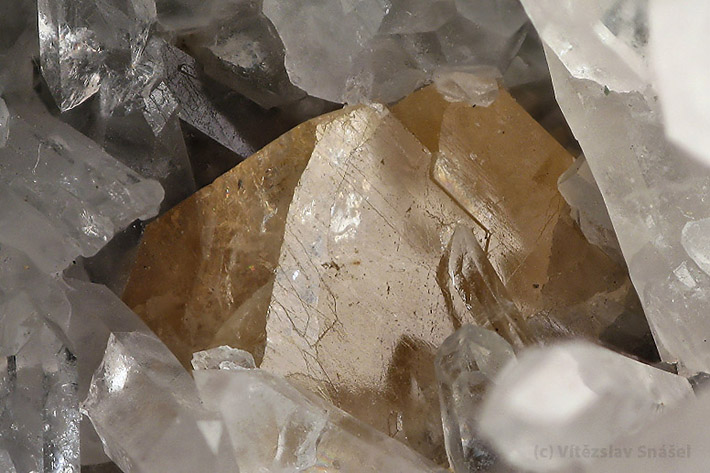
Nice yellow scheelite crystal on quartz from Obri dul, Czech Republic. Size: 1 x 1 cm. Photo: Vitezslav Snasel
There are many productive sites in the USA: Brownish-orange floater crystals of scheelite were found in the Dragoon Mountains at the Cohen Mine, Cochise County, Arizona. Unique white and colorless crystals once came from the Greenhorn Mountains, Kern County, California. Brown, smoky crystals came from Camp Bird Mine, Ouray, Ouray County, Colorado. White to light yellow scheelite was found in Trumbull, Fairfield County, Connecticut. The crystals are large, and many are completely altered to wolframite (reinite).
There is a high concentration of scheelite in northeast Brazil, mainly in the Currais Novo Mine in Rio Grande do Norte State. A deep-orange scheelite came from the Morro Velho Mine, Nova Lima, Minas Gerais, Brazil. Extremely large crystals were found in the Turmalina Mine, Piura, Peru.





Comments